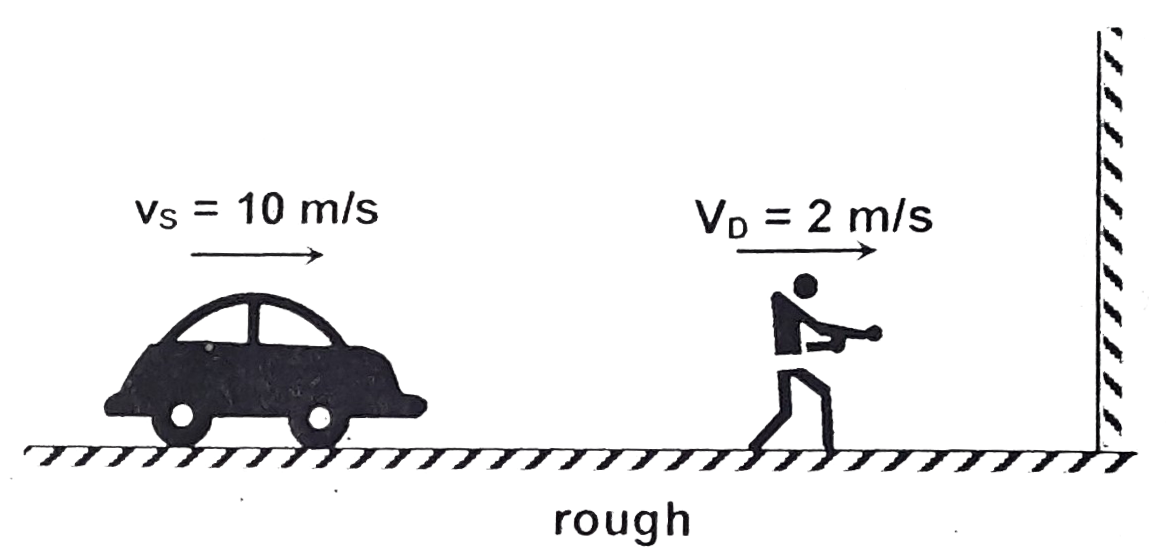Two trains A and B simultaneously start moving along parallel tracks from a station along same direction. A starts with constant acceleration 2ms2 from rest, while B with the same acceleration but with initial velocity of 40 m/s. Twenty seconds after the start, passenger of A hears whistle of B. If frequency of whistle is 1194 Hz and velocity of sound in air is 322 m/s, calculate frequency observed by the passenger.
To solve the problem, we need to follow these steps:
Step 1: Calculate the velocity of Train A after 20 seconds
Train A starts from rest with a constant acceleration of 2m/s2. The formula for the final velocity v after time t is given by:
v=u+at
Where:
- u = initial velocity = 0 (since it starts from rest)
- a = acceleration = 2m/s2
- t = time = 20s
Substituting the values:
vA=0+(2m/s2)(20s)=40m/s
Step 2: Calculate the velocity of Train B after 20 seconds
Train B starts with an initial velocity of 40m/s and also accelerates at 2m/s2. Using the same formula:
vB=u+at
Where:
- u = initial velocity = 40m/s
- a = acceleration = 2m/s2
- t = time = 20s
Substituting the values:
vB=40+(2m/s2)(20s)=40+40=80m/s
Step 3: Calculate the frequency observed by the passenger in Train A
The frequency observed by the passenger can be calculated using the Doppler effect formula for sound. When both the source and observer are moving in the same direction, the formula is:
f′=f(v+vov+vs)
Where:
- f′ = observed frequency
- f = source frequency = 1194Hz
- v = speed of sound in air = 322m/s
- vo = speed of observer (Train A) = 40m/s
- vs = speed of source (Train B) = 80m/s
Substituting the values into the formula:
f′=1194(322+40322+80)
Calculating the numerator and denominator:
f′=1194(362402)
Now, calculating the fraction:
f′=1194×0.9005≈1072.86Hz
Final Result
The frequency observed by the passenger in Train A is approximately 1073Hz.
---
Train A starts from rest with a constant acceleration of 2m/s2. The formula for the final velocity v after time t is given by:
- u = initial velocity = 0 (since it starts from rest)
- a = acceleration = 2m/s2
- t = time = 20s
Train B starts with an initial velocity of 40m/s and also accelerates at 2m/s2. Using the same formula:
- u = initial velocity = 40m/s
- a = acceleration = 2m/s2
- t = time = 20s
The frequency observed by the passenger can be calculated using the Doppler effect formula for sound. When both the source and observer are moving in the same direction, the formula is:
- f′ = observed frequency
- f = source frequency = 1194Hz
- v = speed of sound in air = 322m/s
- vo = speed of observer (Train A) = 40m/s
- vs = speed of source (Train B) = 80m/s
The frequency observed by the passenger in Train A is approximately 1073Hz.
Topper's Solved these Questions
- BOOK - CENGAGE PHYSICS ENGLISHCHAPTER - SOUND WAVES AND DOPPLER EFFECTEXERCISE - Examples56videos
SOUND WAVES AND DOPPLER EFFECT
- BOOK - CENGAGE PHYSICS ENGLISHCHAPTER - SOUND WAVES AND DOPPLER EFFECTEXERCISE - Exercise 6.156videos
SOUND WAVES AND DOPPLER EFFECT
- BOOK - CENGAGE PHYSICS ENGLISHCHAPTER - RIGID BODY DYNAMICS 2EXERCISE - Interger2videos
RIGID BODY DYNAMICS 2
- BOOK - CENGAGE PHYSICS ENGLISHCHAPTER - SUPERPOSITION AND STANDING WAVESEXERCISE - Comprehension Type5videos
SUPERPOSITION AND STANDING WAVES
Similar Questions
A car is moving with a constant velocity 10m/s towards the stationary wall. The car blows a horn of frequency 320Hz. The velocity of sound in air is 330m/s. The beats frequency received by the observer is
 View Solution
View SolutionTwo cars A and B are at rest at same point initially. If A starts with uniform velocity of 40 m/sec and B starts in the same direction with constant acceleration of4m/s2,then B will catch A after :
View SolutionA body moves from rest with a uniform acceleration and travels 270 m in 3 s. Find the velocity of the body at 10 s after the start.
View SolutionA man is travelling in a train towards the station with a speed of 50 m/s. calculate the apparent frequency heard by him of whistle which is blown at the station with a frequency 200 Hz. Velocity of sound in air is 350 m/s.
View SolutionA listener is at rest and a police siren is moving away from the listerner at 60m/s. what frequency does the listerner hear given that the velocity of sound in air is 340m/s and frequency os siren is 500Hz?
View SolutionA cyclist starts from rest and moves with a constant acceleration of 1 m/s2. A boy who is 48 m behind the cyclist starts moving with a constant velocity of 10m/s. After how much time the boy meets the cyclist?
View SolutionCar A and car B start moving simultaneously in the same direction along the line joining them. Car A moves with a constant acceleration a=4m/s2, while car B moves with a constant velocity v=1m/s. At time t=0, car A is 10m behind car B. Find the time when car A overtake car B.
View SolutionAn engine blowing a whistle of frequency 133 Hz moves with a velocity of 60ms towards a hill from which an echo is heard. Calculate the frequency of the echo heard by the driver. (velocity of sound in air in 340ms.)
View SolutionAn engine blowing a whistle of frequency 133 Hz moves with a velocity of 60ms towards a wall from which an echo is heard. Calculate the frequency of the echo heard by the driver. (velocity of sound in air in 340ms.)
View SolutionA man is 45 m behind the bus when the bus starts acceleration from rest with acceleration 2.5ms2. With what minimum velocity should man start running to catch the bus?
View Solution

